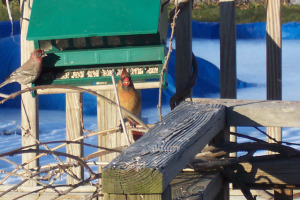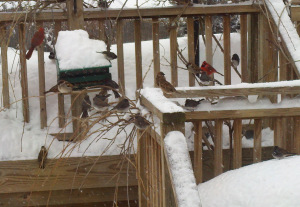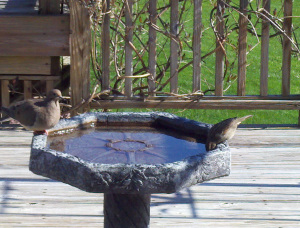As a life-long New Englander I find that one of the most enjoyable parts of the winter season is watching birds at the feeder. We all know the importance of providing easily available food sources for the many avian species that remain in the area during the cold winter months but there are also species that visit during their spring and fall migrations and also during the summer while nesting. According to Audubon over 100 North American bird species supplement their natural diets with birdseed, suet, fruit and nectar obtained from feeders. However, food is not the only resource that should be provided. It is important to also provide fresh water and ample cover.
 While for some people providing food means simply buying a bag of broad-range seed and putting it into a feeder, for others it becomes a hobby that includes tailoring the types of food provided to the specific needs of different birds. Black oil sunflower seed is preferred by many small feeder birds and striped sunflower seed is most easily consumed by large-beaked birds. We use the shelled hearts of black oil sunflower seeds in our feeder. Although it seems more expensive initially a 40lb. bag of seed heart is all seed with no wasted shells. It also has the benefit of eliminating the mess that can accompany whole seeds and the birds don’t expend energy trying to crack open the seeds before they can eat. With some of the frigid temperatures that we have been experiencing this winter our little feathered friends need all of the help that they can get! We attract cardinals, finches, goldfinches, blue jays, chickadees, nuthatches, and juncos to this feeder. Millet and cracked corn are beneficial to ground feeders such as doves, blue jays, sparrows, juncos and crows. Thistle, also called nyjer, will bring goldfinches. An expensive seed, it is best offered in a thistle feeder that has tiny holes that make the seed available only to small-beaked species. Suet will attract insect-eating birds such as woodpeckers, wrens, chickadees, titmice and nuthatches. Suet should not be put out during warm weather as it may go rancid.
While for some people providing food means simply buying a bag of broad-range seed and putting it into a feeder, for others it becomes a hobby that includes tailoring the types of food provided to the specific needs of different birds. Black oil sunflower seed is preferred by many small feeder birds and striped sunflower seed is most easily consumed by large-beaked birds. We use the shelled hearts of black oil sunflower seeds in our feeder. Although it seems more expensive initially a 40lb. bag of seed heart is all seed with no wasted shells. It also has the benefit of eliminating the mess that can accompany whole seeds and the birds don’t expend energy trying to crack open the seeds before they can eat. With some of the frigid temperatures that we have been experiencing this winter our little feathered friends need all of the help that they can get! We attract cardinals, finches, goldfinches, blue jays, chickadees, nuthatches, and juncos to this feeder. Millet and cracked corn are beneficial to ground feeders such as doves, blue jays, sparrows, juncos and crows. Thistle, also called nyjer, will bring goldfinches. An expensive seed, it is best offered in a thistle feeder that has tiny holes that make the seed available only to small-beaked species. Suet will attract insect-eating birds such as woodpeckers, wrens, chickadees, titmice and nuthatches. Suet should not be put out during warm weather as it may go rancid.
The next aspect of providing for the birds is to offer fresh water for drinking and bathing. Fresh water for bathing is especially important during the cold months as it helps them to clean their feathers of dirt that would otherwise allow water to penetrate through to the layer of down and skin. A few years ago we purchased an electric heater for the bird bath. Our investment has more than paid for itself in the amusement that comes from watching the birds drink and splash about. It does require some vigilance on our part as the water level will go down quickly due to consumption, evaporation and spillage. The bird bath should also be scrubbed regularly to keep it clean. Audubon recommends a weak bleach solution, 9-1, of water to bleach once or twice a month. Be sure to rinse it thoroughly. This method is recommended for feeders also.
 Finally, provide ample cover so that birds will feel safe during their eating and bathing. Our feeders are nestled among our wisteria vines which not only give some cover but allow the birds to easily perch as they await their turn at the feeder. Nearby native plants such as winterberry, holly, and fir trees provide food and nesting sites. The birds seem to spend most of the day flying between these areas. So, give them food, water and shelter and then sit back and enjoy the show!
Finally, provide ample cover so that birds will feel safe during their eating and bathing. Our feeders are nestled among our wisteria vines which not only give some cover but allow the birds to easily perch as they await their turn at the feeder. Nearby native plants such as winterberry, holly, and fir trees provide food and nesting sites. The birds seem to spend most of the day flying between these areas. So, give them food, water and shelter and then sit back and enjoy the show!
By: Susan Pelton, UConn Extension Master Gardener